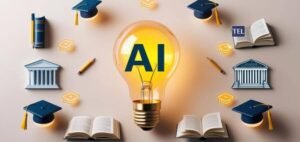The History of EdTech
Yes, a lot has changed within the education sector in the last 10 years. Digital tools, smart classrooms, and online learning platforms have revolutionized how we teach, making it a more interactive and personalized experience. Enter: OpenAI, LLMs (Large Language Models) the revolution of learning — and never before it been at the best edge of technology.
What Are OpenAI and LLMs?
Before diving into how these technologies are revolutionizing the education landscape, it’s worthwhile to understand what OpenAI and LLMs are. OpenAI is the leading global R&D company in artificial intelligence. It has produced some of the most powerful LLM with GPT (Generative Pre-trained Transformer) like LLM, which can understand and generate human-like languages.
LLMs process and generate natural language text by training on billions of data points. They can understand context, answer questions, summarize content, and even generate creative writing — all skills that are changing the way we teach and learn.
Tailored Learning Experiences
And one of the greatest gifts of OpenAI & LLMs in EdTech is the ability to deliver personalized learning. Traditional education methods (albeit leveraging different resources) are often still one-size-fits-all, and every student learns at a different coaching pace and in a different way.
Using LLMs, educational platforms can now assess a student’s history of learning, preferences, and performances to recommend content tailored to them. OpenAI-powered chatbots can guide students through lessons, offer hints and real-time feedback for a more interactive and effective experience.
Intelligent Tutoring Systems
Now, imagine a tutor who is available 24/7 and never gets tired or impatient. That’s the promise offered by OpenAI’s LLMs. Intelligent tutoring systems (ITS) built upon these models can instantly respond to students’ queries, deconstruct intricate concepts into more manageable pieces, and even administer quizzes.
These tutoring AI could be varied and be used in different subjects, learning stages as well as and languages, meaning a good education becomes eligible for students worldwide. ITS platforms are also living, breathing mechanisms, getting better at responding to more precise engagements from users, and OpenAI is at the center of it all.
Shift in Standards for Educators’ Training on Content Generation
Educators spend a lot of time designing courses, examination papers, test questions, and assessments. Enter OpenAI-powered LLMs — teachers can use these to create high-quality education material in a matter of minutes.
Whether it is for creating a history essay prompt or designing a math worksheet, OpenAI tools can assist educators in their content development journey. This gives teachers more time to interact with students and less time to stress about admin tasks.
Train me: The Point of Speech Transfer
LLMs have also made learning other languages so much easier. There are OpenAI-powered platforms now that give you real-time grammar correction and pronunciation feedback in multiple languages and even help you practice conversations. This helps to improve the learning process with quick and accurate assistance for the students.
And, students whose first language is not English would also find help in OpenAI tools that help them write and communicate better confidently in their studies and professional lives.
Advancing Access and Inclusion
OpenAI and LLMs are trailblazing education toward inclusivity. Tools to ensure that students with disabilities can find an equal footing include voice-to-text tools, real-time transcription, and AI-powered reading assistants, for instance.
Moreover, these technologies may also pass on diverse dialects and languages, giving quality education to learners from remote or underprivileged parts of the world. If properly applied, the contribution of LLMs will prevent any student behind.
Use Cases of OpenAI in Education and EdTech
They have been building their powerful learning solutions, taking advantage of OpenAI + LLMs. For instance:
- The Khanmigo AI tutor from Khan Academy is powered by OpenAI technology.
- Duolingo exploits LLMs to create customized and engaging language lessons.
- Now leveraging OpenAI tools, Quizlet has announced new AI-powered functions for students to help them study in a more effective & efficient way.
- All of these are examples, both inside the classroom and out, of how OpenAI and LLMs are no longer perhaps theoretical innovations but tools in practice now transforming classrooms around the world.
Challenges and Considerations
Though it has the potential to offer immense advantages, OpenAI and LLMs in education still pose a number of challenges. These are difficult issues that educators and developers will also need to grapple with, from privacy and data security to ethical data use in using AI. Boundaries need to be set so these technologies are used responsibly and justly.
Finally, educators and learners should have continual training and support systems to leverage AI within their spaces of learning.
OpenAI and the Future of EdTech with LLMs
OpenAI and LLMs are shaping the future of education — smart, inclusive, hyper-personalized. As these technologies improve, many more advanced applications will come to life, from AI-generated course content to virtual experiences inside the classroom.
Endless possibilities await in EdTech with AI. In order to stay relevant along with the other institutions of the digital era, teachers and students alike must adopt this new way of thinking.
Conclusion
Making Sense of OpenAI and LLMs: The Future of Learning This drives modern EdTech solutions with personalized learning pathways, real-time tutoring, and content creation. The role of these four will only deepen nonetheless as we move onwards, making education better anchored, inclusive, and truly transformational.








